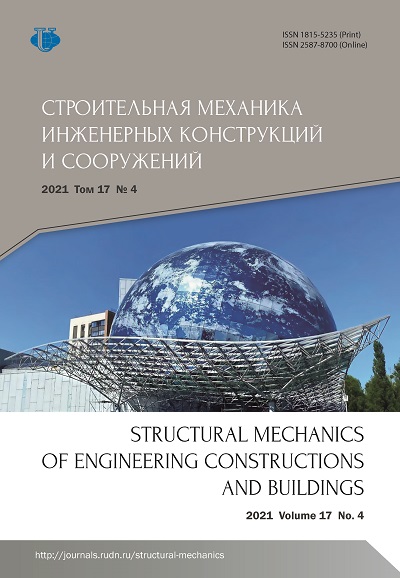Stress-strain state of reinforced concrete structures of the LN-1 and LN-2 retaining walls of Zagorskaya PSPP taking into account the opening of interblock joints and the formation of secondary cracks
- Authors: Khanov N.V.1, Pashchenko F.A.2
-
Affiliations:
- Russian State Agrarian University - Moscow Timiryazev Agricultural Academy
- JSC “LenAeroProekt”
- Issue: Vol 17, No 4 (2021)
- Pages: 324-334
- Section: Analysis and design of building structures
- URL: https://journals.rudn.ru/structural-mechanics/article/view/29949
- DOI: https://doi.org/10.22363/1815-5235-2021-17-4-324-334
Cite item
Full Text
Abstract
Relevance. The lower retaining walls of the water intake of the Zagorskaya PSPP perform the important function of protecting the pressure water conduits from the collapse of the soil massif. Two of them (LN-2 and LN-3) were reinforced with anchor rods. Considering the long period of operation (more than 25 years), certain deviations in the work during examinations and field observations were revealed. So, on the front face of the walls, extended horizontal cracks were recorded (opening of horizontal interblock joints and the emergence of secondary oblique cracks on the front surface of the walls). To carry out computational studies of the stress-strain state of the downstream retaining walls was required. The purpose of the work was to determine the stress-strain state of the lower retaining walls of the water intake of the Zagorskaya PSPP taking into account the opening of interblock joints and the formation of secondary oblique cracks. Methods. Computational studies of the stress-strain state of retaining walls were carried out within the framework of the method of numerical modeling of reinforced concrete structures of hydraulic structures based on finite element models. In finite element models, structural features of retaining walls were reproduced, including anchor rods, horizontal interblock joints, actual reinforcement, secondary oblique cracks. Results. The stress-strain state of the retaining walls was obtained. The stresses in the longitudinal and transverse reinforcement were determined, including when the structure was changed due to anchor rods. In horizontally transverse reinforcement, tensile stresses exceeding the yield point are recorded. It took the development of measures to strengthen the lower retaining walls.
About the authors
Nartmir V. Khanov
Russian State Agrarian University - Moscow Timiryazev Agricultural Academy
Author for correspondence.
Email: vkhanov@yahoo.com
ORCID iD: 0000-0002-5764-4734
Doctor of Technical Sciences, Head of the Department of Hydraulic Structures
19 Pryanishnikova St, Moscow, 127550, Russian FederationFedor A. Pashchenko
JSC “LenAeroProekt”
Email: lenair@lenair.ru
General Manager
122B Naberezhnaya Obvodnogo Kanala, Saint Petersburg, 198095, Russian FederationReferences
- Lisichkin S.Ye. Computational studies of the stability and strength of the first tier retaining walls of Zagorskaya PSPP intake. Prirodoobustroystvo. 2012;(2):44–48. (In Russ.)
- Rubin O.D., Zakharov I.B., Lisichkin S.Ye. Assessment of the state of the Pavlovsk HPS road bridge and calculation and experimental substantiation of strengthen measures of it. Energeticheskoye Stroitel'stvo. 1994;(9):47–50. (In Russ.)
- Lisichkin S.Ye., Rubin O.D., Nefedov A.V. et al. Computational studies of the stress-strain state of the first tier retaining wall LV-1 of Zagorskaya PSPP water intake, including taking into account synchronous measurements with daily changes in the level of the upper accumulating basin. Bezopasnost' Gidrotekhnicheskikh Sooruzheniy. 2013;(18):38–50. (In Russ.)
- Rubin O.D., Baklykov I.V., Antonov A.S. et al. Instrumental and calculated investigations of lower retaining walls of the Zagorskaya PSPP. Prirodoobustroystvo. 2019;(2):80–88. (In Russ.) https://doi.org/10.34677/1997-6011/2019-2-80-88
- Rubin O.D., Ponomarev D.I., Melnikova N.I. Computational studies of the stress-strain state of the first tier retaining walls of Zagorskaya PSPP water intake. Prirodoobustroystvo. 2011;(5):51–55. (In Russ.)
- Ksenofontova T.K., Nyu F. Reinforced concrete retaining walls, the choice of the distance between buttresses. Problems of Development of Land Reclamation and Water Management and Ways to Solve Them: Proceedings of the International Scientific-Practical Conference (Moscow, 11–12 April 2011). Moscow; 2011. p. 106–111. (In Russ.)
- Ahmadi-Nedushan B., Varaee H. Optimal design of reinforced concrete retaining walls using a swarm intelligence technique. Proceedings of the First International Conference on Soft Computing Technology in Civil, Structural and Environmental Engineering (paper 26). Stirlingshire: Civil-Comp Press; 2009. p. 332–343. https://doi.org/10.4203/ccp.92.26
- Nikolaev V.B., Gun S.Ya., Lisichkin S.E., Lyapin O.B. Strength of reinforced-concrete retaining walls. Hydrotechnical Construction. 1988;22(10):616–621. https://doi.org/10.1007/BF01429034
- Chauhan V.B., Murty D., Gade V.K. Investigation of failure of a rigid retaining wall with relief shelves. Japanese Geotechnical Society Special Publication. 2016;2(73):2492–2497. https://doi.org/10.3208/jgssp.TC302-02
- Chauhan V.B., Murty D. Behaviour of rigid retaining wall with relief shelves with cohesive backfill. 5th International Conference on Forensic Geotechnical Engineering (Bangalore, 8–10 December 2016). Bangalore; 2016. p. 350–357.
- Pei Y., Xia Y. Design of reinforced cantilever retaining walls using heuristic optimization algorithms. Procedia Earth and Planetary Science. 2012;(5):32–36. https://doi.org/10.1016/j.proeps.2012.01.006
- Fedorova T.S. The stress-strain state of the walls of the lock chambers of the Moscow Canal (Thesis of Candidate of Technical Sciences). Moscow; 2017. (In Russ.)
- Wu Y., He S., Li X. Failure mechanism and seismic design of retaining wall in earthquake. Environmental Earth Sciences. 2011;65(4):1013–1019. https://doi.org/10.1007/s12665-011-1462-5
















